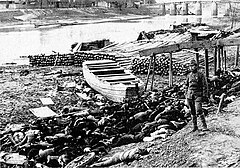
Back Bloedbad van Nanjing Afrikaans مذبحة نانجنغ Arabic Masacre de Nankín AST Nankin qırğını Azerbaijani نانجینق قتلعامی AZB Нанкінская разня Byelorussian Клане в Нанкин Bulgarian নানচিং গণহত্যা Bengali/Bangla Lazhadeg Nanjing Breton Massacre de Nanquín Catalan
| Nanjing Massacre | |
|---|---|
| Part of the Battle of Nanking | |
 A Japanese soldier pictured with the corpses of Chinese civilians by the Qinhuai River | |
| Location | Nanjing, Jiangsu, China |
| Coordinates | 32°2′15″N 118°44′15″E / 32.03750°N 118.73750°E |
| Date | From December 13, 1937, for six weeks[a] |
| Target | Chinese people |
Attack type | Mass murder, wartime rape, looting, torture, arson |
| Deaths | 200,000+ civilians and POWs (IMTFE Judgement),[1] estimates range from 40,000 to over 300,000 |
| Victims | 20,000 to 80,000 women and children raped, 30,000 to 40,000 POWs executed (another 20,000 male civilians falsely accused of being soldiers executed) |
| Perpetrators | Imperial Japanese Army
|
| Motive | |
| This article is part of the series on the |
| Nanjing Massacre |
|---|
| Japanese war crimes |
| Historiography |
| Films |
| Books |
| History of the Republic of China |
|---|
 |
|
|
The Nanjing Massacre[b] or the Rape of Nanjing (formerly romanized as Nanking[c]) was the mass murder of Chinese civilians by the Imperial Japanese Army in Nanjing, the capital of the Republic of China, immediately after the Battle of Nanking and retreat of the National Revolutionary Army during the Second Sino-Japanese War.[2][3][4][5] The massacre took place over a period of six weeks beginning on December 13, 1937.[a] Estimates of the death toll vary from a low of 40,000 to a high of over 300,000, and estimates of rapes range from 20,000 to over 80,000. Most scholars support the validity of the International Military Tribunal for the Far East, which estimated that at least 200,000 were killed. Other crimes included torture, looting, and arson. The massacre is considered one of the worst wartime atrocities in history.[7][8][9] In addition to civilians, numerous POWs and men who looked of military-age were indiscriminately murdered.
After the outbreak of the war in July 1937, the Japanese had pushed quickly through China after capturing Shanghai in November. As the Japanese marched on Nanjing, they committed violent atrocities in a terror campaign, including killing contests and massacring entire villages.[10] By early December, the Japanese Central China Area Army under the command of General Iwane Matsui reached the outskirts of the city. Nazi German citizen John Rabe created the Nanking Safety Zone in an attempt to protect its civilians. Prince Yasuhiko Asaka was installed as temporary commander in the campaign, and he issued an order to "kill all captives". Iwane and Asaka took no action to stop the massacre after it began.
The massacre began on December 13 after Japanese troops entered the city after days of intense fighting and continued to rampage through it unchecked. Civilians, including children, women, and the elderly, were murdered. Thousands of captured Chinese soldiers were summarily executed en masse in violation of the laws of war, as were male civilians falsely accused of being soldiers. Widespread rape of female civilians took place, their ages ranging from infants to the elderly, and one third of the city was destroyed by arson. Rape victims were murdered afterward. Rabe's Safety Zone was mostly a success, and is credited with saving at least 200,000 lives. After the war, Matsui and several other commanders at Nanking were found guilty of war crimes and executed. Some other Japanese military leaders in charge at the time of the Nanjing Massacre were not tried only because by the time of the tribunals they had either already been killed or committed ritual suicide. Asaka was granted immunity as a member of the imperial family and never tried.
The massacre remains a contentious topic in Sino-Japanese relations, as Japanese nationalists and historical revisionists, including top government officials, have either denied or minimized the massacre.
Cite error: There are <ref group=lower-alpha> tags or {{efn}} templates on this page, but the references will not show without a {{reflist|group=lower-alpha}} template or {{notelist}} template (see the help page).
- ^ Library of Congress, ed. (November 1948). Judgment International Military Tribunal for the Far East The Pacific War (PDF). p. 1015.
- ^ "International Memory of the World Register Documents of Nanjing Massacre" (PDF). UNESCO. Archived (PDF) from the original on April 17, 2022. Retrieved March 23, 2022.
- ^ Smalley, Martha L. (1997). American Missionary Eyewitnesses to the Nanking Massacre, 1937-1938. Connecticut: Yale Divinity Library Occasional Publications. Archived from the original on January 24, 2024. Retrieved April 3, 2024.
- ^ Chang, Iris. 1997. The Rape of Nanking. p. 6.
- ^ Lee, Min (March 31, 2010). "New film has Japan vets confessing to Nanjing rape". Salon. Associated Press. Archived from the original on October 31, 2022. Retrieved February 25, 2012.
- ^ Library of Congress, ed. (1964–1974). "29 July 1946. Prosecution's Witnesses. Bates, Miner Searle". Record of proceedings of the International Military Tribunal for the Far East. pp. 2631, 2635, 2636, 2642–2645. Archived from the original on December 14, 2021. Retrieved December 14, 2021.
- ^ Cite error: The named reference
Yamamoto M. 2000was invoked but never defined (see the help page). - ^ Cite error: The named reference
Awas invoked but never defined (see the help page). - ^ Fogel 2000, p. backcover.
- ^ Cite error: The named reference
:5was invoked but never defined (see the help page).